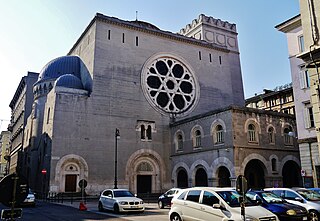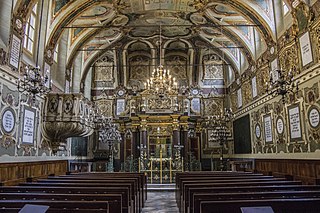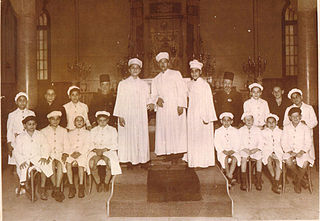
The Roman Ghetto or Ghetto of Rome was a Jewish ghetto established in 1555 in the Rione Sant'Angelo, in Rome, Italy, in the area surrounded by present-day Via del Portico d'Ottavia, Lungotevere dei Cenci, Via del Progresso and Via di Santa Maria del Pianto, close to the River Tiber and the Theatre of Marcellus. With the exception of brief periods under Napoleon from 1808 to 1815 and under the Roman Republics of 1798–99 and 1849, the ghetto of Rome was controlled by the papacy until the capture of Rome in 1870.

The history of the Jews in Italy spans more than two thousand years to the present. The Jewish presence in Italy dates to the pre-Christian Roman period and has continued, despite periods of extreme persecution and expulsions, until the present. As of 2019, the estimated core Jewish population in Italy numbers around 45,000.

The Great Synagogue of Rome is an Orthodox Jewish congregation and synagogue, that is located at Lungotevere de' Cenci, in Rome, in Lazio, Italy. Designed by Vincenzo Costa and Osvaldo Armanni in an eclectic mix of Historicism and Art Nouveau styles, the synagogue was completed in 1904. It is the largest synagogue in Rome.
The Lateran Museum was a museum founded by the Popes and housed in the Lateran Palace, adjacent to the Archbasilica of Saint John Lateran in Rome, Italy. It ceased to exist in 1970.

Sant'Angelo is the 11th rione of Rome, Italy, located in Municipio I. Often written as rione XI - Sant'Angelo, it has a coat of arms with an angel on a red background, holding a palm branch in its left hand. In another version, the angel holds a sword in its right hand and a scale in its left.
Italian Jews or Roman Jews can be used in a broad sense to mean all Jews living in or with roots in Italy, or, in a narrower sense, to mean the Italkim, an ancient community living in Italy since the Ancient Roman era, who use the Italian liturgy as distinct from those Jewish communities in Italy dating from medieval or modern times who use the Sephardic liturgy or the Nusach Ashkenaz.

The history of the Jews in Trieste goes back over 800 years.

The history of the Jewish community of Venice, the capital of the Veneto region of Italy, has been well known since the medieval era.

The Sardis Synagogue is a former ancient Jewish synagogue, that was discovered in the modern-day town of Sardis, in the Manisa Province, in the Aegean Region of western Turkey. The former synagogue building is now an archaeological site and Jewish museum. The archaeological site is the largest Jewish site known from antiquity.
This timeline of antisemitism chronicles events in the history of antisemitism, hostile actions or discrimination against Jews as members of a religious and/or ethnic group. It includes events in Jewish history and the history of antisemitic thought, actions which were undertaken in order to counter antisemitism or alleviate its effects, and events that affected the prevalence of antisemitism in later years. The history of antisemitism can be traced from ancient times to the present day.
The history of the Jews in Turin, Italy, can be first traced to the 4th century when bishop Maximus of Turin recorded the presence of Jews in the city. The city of Turin is in north-west Italy and is the capital of the Piedmont region.

The Synagogue of Casale Monferrato is an Orthodox Jewish congregation and synagogue, located at Vicolo Salomone Olper 44, in the Jewish quarter of Casale Monferrato, Province of Alessandria, in the region of Piedmont, Italy. Built in the Piedmontese Baroque and Mannerist styles, the synagogue was completed in 1595.

Roman cuisine comes from the Italian city of Rome. It features fresh, seasonal and simply-prepared ingredients from the Roman Campagna. These include peas, globe artichokes and fava beans, shellfish, milk-fed lamb and goat, and cheeses such as pecorino romano and ricotta. Olive oil is used mostly to dress raw vegetables, while strutto and fat from prosciutto are preferred for frying. The most popular sweets in Rome are small individual pastries called pasticcini, gelato and handmade chocolates and candies. Special dishes are often reserved for different days of the week; for example, gnocchi is eaten on Thursdays, baccalà on Fridays, and trippa on Saturdays.
The history of the Jews in Sardinia can be traced over two millennia. The modest Jewish community in Sardinia consisted of Sephardic Jews of Spanish and Italian descent.
The Palazzo Pannolini is a Renaissance-style palace located on Via Valdonica 1/5 in Bologna, region of Emilia Romagna, Italy. The palace, owned by the comune, since 1999 houses the Museo Ebraico di Bologna or Jewish Museum of Bologna.

The Museum of Italian Judaism and the Shoah (MEIS) is a public history museum in Ferrara, Italy. It opened in 2017, and traces the history of the Jewish people in Italy starting from the Roman empire through the Holocaust of the 20th century. Chartered by the Italian government in 2003, MEIS contains over 200 artifacts and exhibits that proceed chronologically through the periods of Jewish history in Italy. The museum is continuing to expand through the year 2021.

The history of the Jews in Alexandria dates back to the founding of the city by Alexander the Great in 332 BCE. Jews in Alexandria played a crucial role in the political, economic, cultural and religious life of Hellenistic and Roman Alexandria, with Jews comprising about 35% of the city's population during the Roman Era.

The Jewish Museum of Florence is a museum of Jewish history located in the Great Synagogue of Florence, Italy. The museum, which covers two spaces of the building, gathers an important collection of ancient objects of Jewish ceremonial art, evidence of the high artistic level achieved by the Jewish-Italian communities in the field of applied arts. Exhibitions illustrate the history of Florentine Jews from the first settlements to the post-war reconstruction, featuring old photographs, films and a large number of objects of daily and commemorative use.

The Jewish Museum of Venice is a museum focusing on the history of Jews in the city of Venice.
The Jewish community in Rome is one of the oldest in Europe, with its origins tracing back to at least 161 BCE.

















